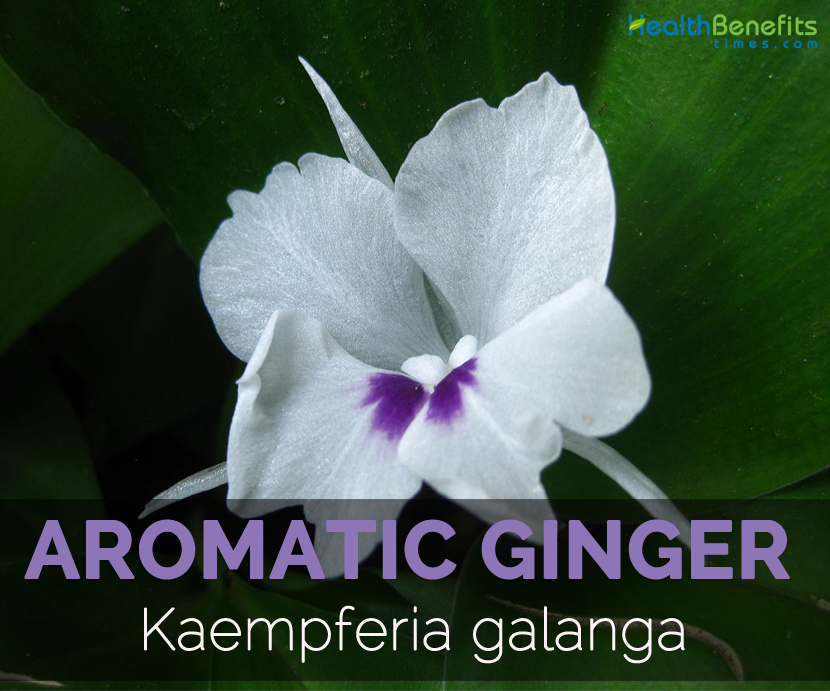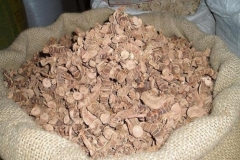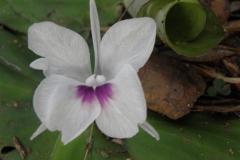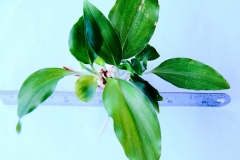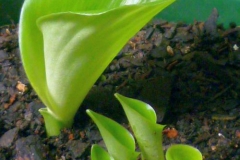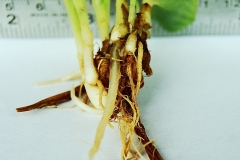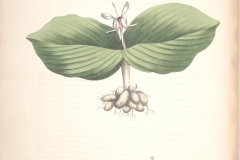Aromatic ginger belongs to Zingiberaceae with 20 genera out of known 53 genera. It is a small monocotyledonous herb which grows to the height of 1 to 3 inches and used for medicinal properties since decades. It has no central stem or stalk. Leaves grow right off the rhizome and leaves are 6 inches long. Some varieties have glossy solid green leaves. The blossoms are small white and fragrant about 1 inch (2 ½ cm) wide with a splash of purple at the center or lip. It is found in open areas in South-east Asian countries such as Southern China, Indonesia, Cambodia and Taiwan. It is roasted, air-dried and used ground on its own or mixed in spice.
Plant description
Kaempferia galangal, a perennial low, rhizomatous and stemless with pale yellow to yellowish green rhizomes. Leaves are 2-3-5 spreading low and horizontally on ground. Leaf blade is green, broadly ovate to sub-orbicular about 7–20 × 3–17 cm and glabrous on both surfaces or villous abaxially. An inflorescence is terminal that emerges from leaves enclosed by imbricate leaf sheaths and sessile. Bracts are 2.5 cm long and lanceolate. Corolla tube is 2 to 2.5 cm long and lobes are white. Apex is 2-cleft, labellum is 2.5 × 2 cm.
Health Benefits of Aromatic ginger
- Increased energy
Aromatic ginger promotes energy. Boil 2 cm of aromatic ginger with a glass of water and drink this before sleep. Furthermore, Japanese and Tibetan incense formulas contain this rhizome especially to enhance energy, awareness, create peaceful environment and overcome exhaustion.
- Enhance appetite
Aromatic ginger has carminative property which helps to enhance appetite.
- Lowers bad cholesterol
Aromatic ginger promotes the production of bile in the body. The bile is responsible for absorption of nutrients; eliminate toxins such as bad cholesterol.
- Source of antioxidant
Antioxidant eliminates free radical and viruses. This makes aromatic ginger beneficial for immunity.
- Cure for cough
Aromatic ginger solution is a cure for coughing symptoms. Wash roots, peel and grate them. Twist the the cloth with aromatic ginger and extort the juice. Add lime juice and honey to taste and drink aromatic ginger syrup thrice a day till the symptoms recede.
- Reduce bloating
Wash and eat raw aromatic ginger with salt and wash with warm water. Boil 3 cm of aromatic ginger roots with a glass of water. Drink the solution or eat root twice a day by preventing bloating.
- Treat sprained muscle
Mix one aromatic ginger rhizome with mashed raw rice. Apply it to affected area.
Traditional uses
- It stimulates stomach, relieves pain, promotes digestion and dyspepsia, abdominal pain and astralgia.
- It treats rheumatism, oedema and arthralgia.
- Apply it to teeth as a cure for dental caries.
- Mix it with honey and use it for cough and chest pain.
- Flowers and leaves are used for treating eye diseases and seizures.
- Use the decoction or powder for cold, indigestion, abdominal and pectoral pains, toothache and headache or gargle.
- Leaves are added to lotions or used as a poultice or fevers, sore throats, rheumatism, swellings and sore eyes.
- Apply the leaves ash to swollen breast.
- Rhizome is used or treating swelling as well as muscular rheumatism.
- Apply the leaves to forehead to provide relief from colds and nosebleeds.
- Filipinos use the rhizomes decoction for headaches, dyspepsia and malarial chills.
- Use it in hair wash to eliminate dandruff.
- In China, it is used for treating pectoral and abdominal pains, hypertension, toothache, headache, dyspepsia, rheumatism, coughs and inflammatory tumors.
- It is helpful for stress, restlessness, depression and anxiety.
- Apply the rhizome oil to provide relief from nasal congestion.
- Use the leaves internally for bronchial complaints, colds, gastric complaints and dyspepsia.
- Use the root poultice externally for swellings, wounds and ulcers.
- Chew the leaves for sore throat and coughs.
- Mix with the juice of Cucurma montana, ginger rhizomes and C. aromatic to facilitate childbirth.
- For mumps, apply the rhizomes on swollen glands for 30 minutes for three times daily.
- Apply the hot rhizomes on rheumatic afflictions.
- In Malaysia, it is used for stomach pains and cough.
Culinary uses
- Use it as a spice or flavoring for foods.
- Leaves are used as an ingredient in curries.
- Rhizomes are used for preparing beverage known as beras kencur.
- Extract essential oil from the rhizomes by distillation.
- Young leaves are consumed raw or steamed or added to curries.
- Cook the leaves with chilli paste or use it as a side dish with rice.
References:
https://www.itis.gov/servlet/SingleRpt/SingleRpt?search_topic=TSN&search_value=506507#null
http://tropical.theferns.info/viewtropical.php?id=Kaempferia+galanga
https://www.academia.edu/22291324/Essential_Oils_of_Leaves_and_Rhizomes_of_Kaempferia_Galanga_Linn
http://medicinalplants.us/kaempferia-galanga
http://entheology.com/plants/kaempferia-galanga-galanga/
http://www.stuartxchange.org/Dusol.html
https://www.indoindians.com/kencur-the-wonderful-herb-with-many-benefits/
Comments
comments
| Aromatic Ginger Quick Facts | |
|---|---|
| Name: | Aromatic Ginger |
| Scientific Name: | Kaempferia galanga |
| Origin | India and widely cultivated in India and SE Asia (Mainland SE Asia, Java, Philippines, New Guinea) |
| Flesh colors | White |
| Taste | Strong, sickly sweet |
